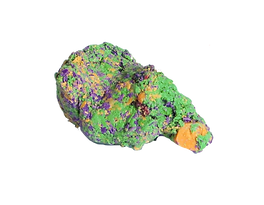What's the difference between sedimentary metamorphic, and igneous rocks? How can a rock cycle diagram help us? Do all minerals have the same crystal shape? What is the Mohs scale of hardness? Lab activities dig into these questions and are great for classrooms or homeschool.
Are Your Students Engaged?
Are you looking for a way to engage kids in their science learning? Are you eager to see your students become scientists in your classroom?
That's the goal of this course...
Activity Highlights
Minerals are made of crystals and crystals have definite shapes. Building models of these helps kids see the specific angles of the different geometric shapes.
Growing crystals is pretty magical. Different substances make different (specific) shapes.
Minerals are identifiable by a variety of features. One of these is hardness. One of the labs walks kids through the process of measuring mineral hardness like a geologist.
The rock cycle is a circle. Lay out paper pieces to solve the puzzle and show the pattern of how rock moves through each of the stages.
Use crayons to simulate rock formation--make sedimentary, metamorphic, and igneous and see how they differ.
What's Included in the Course/Unit?
- • Written instructions include:
› Simple directions (written to students)
› Questions and writing prompts
› Explanations for the students and teacher
› Guidance for writing formal lab reports.
› Scaffolded writing prompts.
› Answer keys to help with assessing student work.
› List of materials and setup hints.
› Course platform with a forum for asking questions if you need further clarification or support.
Concepts and Topics Addressed in this Unit:
- ✦ Minerals are inorganic solids
✦ Minerals are crystalline
✦ Minerals have specific physical properties (hardness, etc)
✦ Minerals are naturally occurring
✦ Minerals are identified by color, streak, luster, hardness
✦ Minerals form from magma and lava
✦ Minerals form from dissolved substances
✦ Rocks are composed of one or more minerals
✦ There are three types of rocks (Sedimentary, Metamorphic, and Igneous)
✦ Sedimentary rocks are formed from sediment that is cemented and compacted
✦ Igneous rocks form from crystallized lava or magma
✦ Metamorphic rocks are formed when other rocks are under high temperature and or pressure
✦ Any rock type can become any other rock type through a series of processes
Invite students to become scientists in your classroom
As fellow scientists they need to learn to investigate, discover, measure, observe, examine...
And these skills take time and repetition.
But repeating stuff can be boring…
That’s where labs come in!
Many of the labs are teaching the same fundamentals but use different materials to keep things interesting.
What if you don’t have time to research the science behind a concept?
I’ve got you covered... Sections in the written instructions and the videos should answer your questions. Here you’ll also find hints and helps for running an activity. Additionally, the Teacher Notes sections will give you plenty of background information. You won’t have to do any outside research unless you want to.
What if your kids are at different levels?
Ah, differentiation! In my classroom everyone did the Core Labs—marked by Δ. These are the labs we talk about in our discussions and they provide the content for what we test. Extension Labs go deeper or broader—some are tangents, and some repeat the core concepts for kids who need that.
What if you don’t have time to introduce a lab?
No worries! if students work at at their own pace they can be independent and work through the instructions.The lab instructions are written directly to the students so you can just print and go.
When does the course start?
This course is a collection of lessons to use in your classroom. You can start as soon as you sign up!
Can I access these resources from my phone or tablet?
Sure! It works well on any device.
Do I have to go in order?
Nope! You can use the lessons in any order—I always arrange them in a way I think makes sense, however since students in my classes worked at their own pace, they also tended to do the lessons in their preferred order. Within each section, the lessons progress from concrete to more abstract and from fundamental concepts to more tangential ones.
Who is this course for?
This course is designed for teachers to give them hands-on resources to teach middle school science.
Will this course work for homeschoolers?
I think so, though my background is classroom teaching. It’s not designed like a plug and play course. It’s a collection of activities that will help you teach the content.
What if I am unhappy with the course?
We would never want you to be unhappy! If you are unsatisfied with your purchase, contact us in the first 30 days and we will give you a full refund.
How long do I have access to the course?
After enrolling, you have unlimited access to this course - across any and all devices you own.

Meet the author...
Hi, I'm Carolyn Balch, the author of Engaging Science Labs. I started my career as a high school physics teacher. Then I entered the field of museum education at the National Air and Space Museum (part of the Smithsonian Institution) where I wrote science education materials and ran teacher workshops. When my children were born, I left the workforce and when they were little, our family got involved with a school start up. My children grew and with them, the school;
I volunteered on a weekly basis, running science experiments for my son's class and joined the faculty as the middle school science teacher when the seventh grade was added. Now I write full-time, working to publish the curriculum I developed while I was teaching. Each online course is a unit of study from a hands-on, laboratory-experience perspective.





